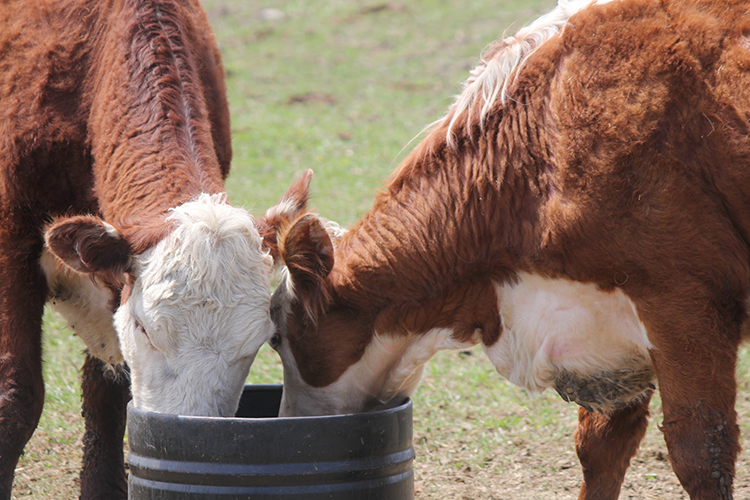
For many cow–calf operations, especially in regions where rangeland is the primary feed source, native forages supply much of the herd’s diet. In other areas, pastures containing fescue, bermudagrass, or smooth bromegrass serve a similar role. In both systems, forage is usually the most economical feed available. But whether cattle are grazing native range or improved pastures, forage quality is far from consistent. Nutrient levels shift with the season, rainfall, and soil type, and those changes directly affect cattle performance.
Across the country, ranchers know the frustrations of thin cows, delayed rebreeding, or weak calves. Often, the underlying cause isn’t forage quantity, but forage quality, and protein and mineral deficiencies are some of the most limiting factors in grazing systems.
Balance, not Band-Aids
Cattle turn poor-quality forage into usable energy thanks to the microbes in the rumen, and those microbes require a minimum level of dietary protein to do their job. Research shows that once forage crude protein drops below about 6.25%, microbial activity in the rumen slows dramatically. When that happens, cows digest less of the forage they consume, and they eat less forage. Then, body condition slips, reproduction suffers, and milk production declines.
Protein deficiencies are most common in late spring and during the winter when mature, weathered grasses dominate pastures. This is true on both native ranges in the West and established pastures in the East and Midwest. Offering cattle a protein supplement containing at least 22% crude protein can make a difference. It doesn’t just add nutrients — it jump-starts the rumen microbes, allowing cows to get more out of every bite of forage.
Protein may be the first limiting nutrient, but minerals are close behind. Even in areas with plenty of grass, forage is often lacking in essential macro- and microminerals. Deficiencies may not cause dramatic symptoms at first, but they chip away at reproduction, immunity, and calf performance.
Some of the most common mineral challenges include:
• Calcium and phosphorus: Both are critical for bone development and energy metabolism. Forages are frequently low in calcium and phosphorus, and the balance between them is often off kilter. Ideally, the calcium-to-phosphorus ratio should be about 2-to-1.
• Magnesium: Low levels, especially in lush spring forage, can contribute to grass tetany.
• Potassium and sulfur: Deficiencies are variable, but both are needed for muscle function and protein synthesis.
• Copper and zinc: Often deficient in grazing systems nationwide, these minerals support immunity, reproduction, and hoof and skin health.
• Selenium: Some regions have toxic levels, while others — especially the West and parts of the Southeast — have virtually none. Selenium deficiency raises the risk of white muscle disease in calves, retained placentas, and poor reproductive performance.
One complicating factor is that minerals interact. High iron, sulfur, or molybdenum can tie up copper absorption. Excess potassium can worsen magnesium deficiency. That’s why supplementation isn’t as simple as adding one missing nutrient — it requires balance.
Rainfall patterns also influence nutrient content. Protein can spike after timely moisture, but in drought years, it may remain depressed. Minerals fluctuate as well — copper, for example, often varies with rainfall. Soil type also plays a role, with sandy soils tending to be lower in certain nutrients than clay soils.
Another reason to test
These patterns are not unique to Western rangelands. Even in managed pastures, nutrient levels vary with weather, soil fertility, and plant maturity. This variability highlights the value of forage testing. Even occasional samples can reveal trends and help guide supplement decisions.
While the science of nutrition can
be quite complex, the practical steps are straightforward:
• Test when you can. Forage testing isn’t necessary every season, but periodic samples give a clearer picture of what your herd is consuming.
• Plan for seasonal lows. Expect protein dips in late spring and winter. Have a protein supplement on hand during those times to keep cows on track.
• Read the mineral tag. Don’t assume all mineral mixes are alike. Make sure products are formulated for your region, and look closely for selenium content — especially if your forages are deficient.
• Work with a nutritionist or extension professional. They can help you identify the most likely deficiencies in your area and recommend cost-effective supplement strategies.
• Be consistent. Supplementation doesn’t need to be perfect to be effective. Providing steady access to a well-balanced mineral product covers the gaps most of the time.
Whether cattle are grazing native range or established pastures, forage has limits. Protein levels often dip below the threshold needed for rumen function, and many minerals — copper, zinc, phosphorus, selenium, and more — are often deficient.
Ignoring these gaps has real costs for reproduction, calf vigor, and overall herd performance. Fortunately, filling them doesn’t require perfect precision. A targeted protein supplement and a well-formulated mineral mix, chosen with regional needs in mind, are usually enough to keep cattle thriving.
This article appeared in the November 2025 issue of Hay & Forage Grower on page 10.
Not a subscriber? Click to get the print magazine.
